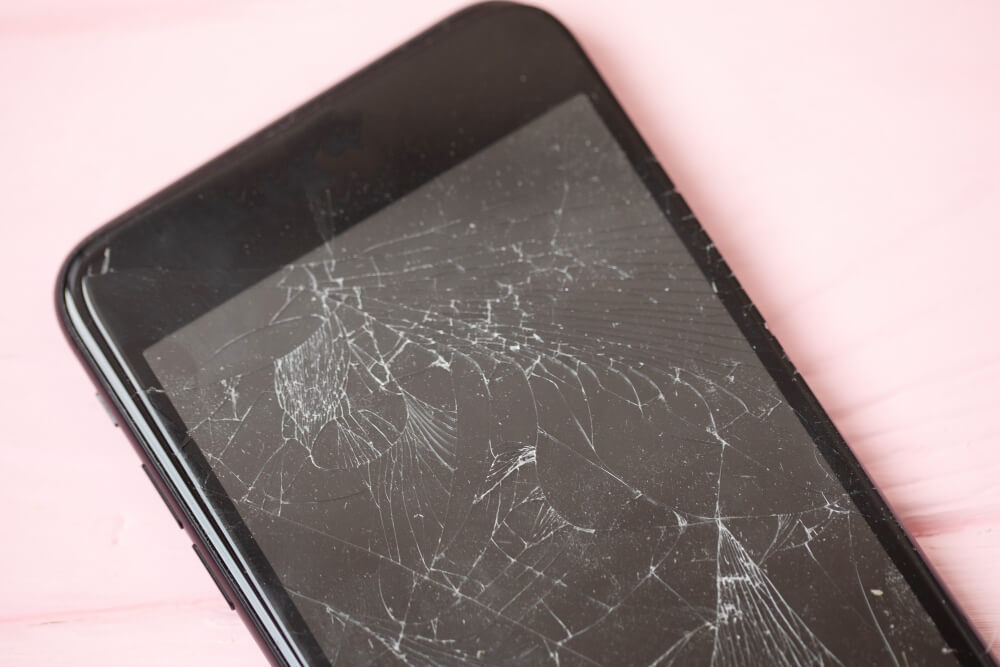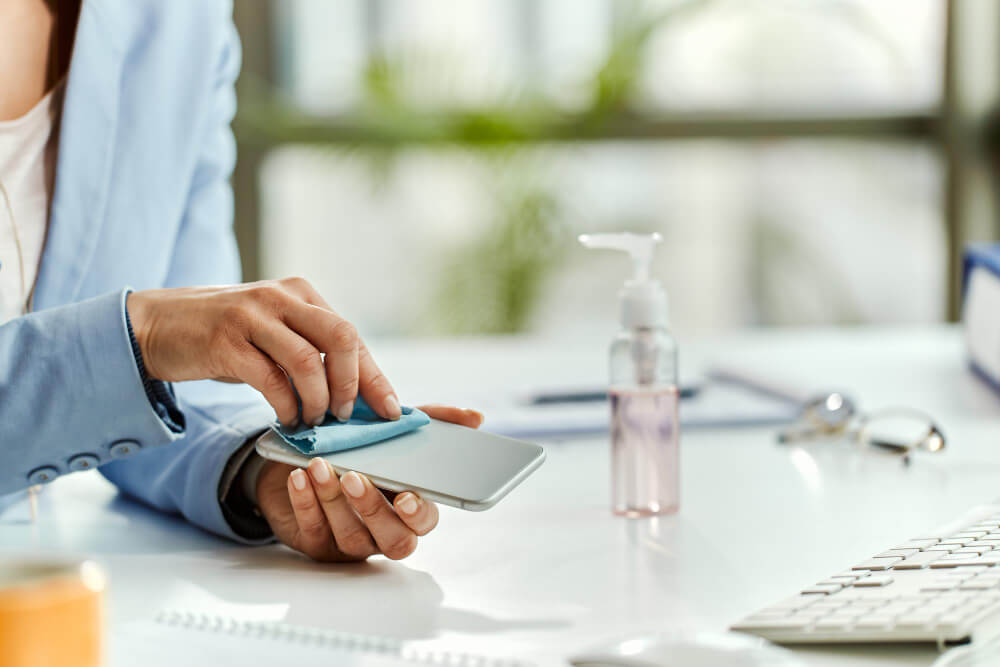Phone screens can still get damaged even if they are designed to be resistant to breaking and scratches. In essence, regular use of a smartphone wears it down, causing cracks and scratches to appear.
Fortunately, screen protectors are an inexpensive damage-prevention material that is frequently purchased to extend a screen’s durability. In fact, according to Grand View Research, the market for smartphone screen protectors is projected to reach $84.96 billion by 2030.
However, a common question usually asked is whether one can put a screen protector on a cracked screen. This blog seeks to answer just that!
Types of screen damage
Three main types of screen damage may occur to phones and tablets.
Here’s a descriptive breakdown of each:
- Minor cracks: These are small, superficial damages that typically do not affect the functionality of the screen. They may appear as thin lines or small fissures on the surface.These cracks usually don’t interfere with touch sensitivity or display quality. In fact, they can sometimes be repaired without replacing the entire screen.
- Major cracks: These are larger and more pronounced than minor cracks. They may extend across the screen and can create visible disruptions in the display, like distortion or dead pixels.They usually affect touch functionality and may lead to further damage if not addressed promptly. They often require a professional assessment to determine if repair or replacement is necessary.
- Shattered screens: This type of screen damage is characterised by the glass being severely broken into multiple pieces— rendering the device unusable. In some instances, shattered glass may expose internal components to further damage.
Does a cracked screen matter?
Depending on the severity of the damage, a cracked screen can have varied effects on a smartphone’s usability. A cracked screen may allow dust and moisture to enter the device and increase the risk of internal damage.
Furthermore, it may affect touch responsiveness, which makes it challenging to use apps and carry out necessary duties. It may also result in optical obstructions, causing eye strain and pain. Lastly, a cracked screen may also present a safety risk because the jagged edges of the glass can cut or injure someone.
Risks of ignoring a cracked screen
Ignoring a cracked screen on your phone or tablet may pose several risks and long-term consequences, for example:
- Vulnerability to additional impacts, making it more likely to shatter upon subsequent drops.
- Risk of cuts and injuries, especially when interacting with the touchscreen.
- Impairment of the touchscreen’s responsiveness and accuracy, leading to unresponsive areas, delayed response times— or even misinterpretation of touch inputs.
- User frustration when performing app tasks.
- Eye strain, discomfort, and headaches over prolonged usage.
- Creation of openings for water, dirt, and oil to infiltrate the device,
- Increased risk of malfunctions, corrosion, and irreversible damage to the device.
- Risk of more extensive repairs in the future, which may become complex and costly.
What is a screen protector?
A screen protector is an accessory expressly designed to safeguard the display of mobile devices from various forms of damage, including scratches, cracks, and smudges. Directly applied to the screen surface, they are intended to absorb impacts and are typically composed of materials with brittle properties.
Tempered glass and TPU (thermoplastic polyurethane) are the two most popular materials for screen protectors. Tempered glass is said to be superior to TPU since it offers exceptional protection against scratches and impacts. It is, nevertheless, also the priciest.
Also known as plastic film screen protectors, TPU screen protectors are a lightweight, popular alternative to tempered glass. In addition to its durability, TPU is highly flexible and can self-heal minor scratches.
Liquid screen protectors are a more recent innovation. These protectors are made of a liquid solution that is put directly on the screen, in contrast to conventional film or glass. After curing, it leaves behind a thin, undetectable coating that provides resistance to scratches and occasionally enhances screen hardness.
Liquid screen protectors have the major benefit of working with any smartphone, no matter how big or curved the screen is. The end product is a smooth surface that doesn’t interfere with touch sensitivity, and its application is easy and bubble-free.
Can I add a screen protector to a cracked screen?
Yes, you can ideally add a screen protector to a cracked screen. However, there are some caveats to consider.
The severity of the crack:
Minor vs. major cracks: If the screen has only minor cracks, applying a screen protector can help prevent further damage and may provide a smoother surface for touch interactions.
However, in cases of major cracks, the structural integrity of the screen may be compromised. So, applying a screen protector might not be effective, as it could fail to adhere properly to the uneven surface.
Type of screen protector
Tempered glass vs. plastic: Tempered glass protectors tend to offer superior protection against impacts and scratches. However, if the underlying screen is severely cracked, the protector may not adhere well, and the risk of further shattering exists.
Plastic film protectors, on the other hand, provide basic protection against scratches and may be suitable for minor cracks. This is because they can conform to the screen’s surface better than tempered glass.
Screen responsiveness
Wondering if a protector will affect touch sensitivity? Tempered glass is designed to maintain touch sensitivity. However, if the screen is already compromised with cracks, applying a protector may not restore full functionality.
If the screen already has issues with touch sensitivity, it may be prudent to repair the screen first since a protector may not resolve these underlying problems.
Installation challenges
It is imperative to consider installation challenges if deciding to install a protector on a cracked screen. If it seems complicated to install, abort the mission. To properly apply a screen protector to a damaged screen:
- Always clean the screen thoroughly with a microfiber cloth to remove dust and debris.
- Meticulously align the screen protector with the edges of the screen. This can be challenging with cracks, so take your time to avoid misalignment, which may lead to bubbles or peeling.
- If air bubbles form, utilise a credit card or similar object to gently push them towards the edges.
Why consider a screen protector on a cracked screen?
When dealing with a cracked screen, applying a screen protector can be a considerable makeshift solution for several reasons:
Helps prevent further damage
A screen protector may act as a barrier that helps prevent existing cracks from spreading further. When a device is dropped or subjected to pressure, the protective layer can absorb some of the impact, reducing the likelihood of additional damage.
Improving usability
It can significantly enhance usability by making the device safer to handle. Cracks may produce sharp edges that pose a risk of cuts or injuries to users, particularly when swiping or tapping on the screen. So, a screen protector smooths over these jagged edges, reducing the risk of finger cuts.
Aesthetic improvements
A screen protector won’t completely hide the cracks but can mask minor imperfections and provide a uniform surface that augments the visual appeal of the device.
Temporary vs. long-Term solutions
A screen protector is more of a short-term than a long-term solution. It doesn’t deal with the root cause of the cracked screen, but it can assist in reducing risks and enhancing usage in the short term.
So, it is important to think about professional repairs or screen replacement for long-term usability and safety.
Best screen protector for cracked screen
The consumer electronics sector, which includes accessories for mobile phones like screen protectors, has placed a greater emphasis on eco-friendliness and sustainability in recent years.
In fact, as a more environmentally friendly alternative to conventional ones, some screen protectors are constructed from recyclable materials or bio-based plastics.
For cracked screens, you can employ custom-cut and ultra-thin tempered glass screen protectors to lessen the visibility of cracks.
Custom-cut screen protectors are the superior, sustainable, and environmentally friendly choice because they are precisely tailored to fit your device’s screen. Thus, ensuring maximum coverage and protection for the cracked area.
FAQ
How can I protect my cracked phone screen?
In addition to a screen protector, using a sturdy phone case can significantly enhance a cracked phone screen’s protection against impacts and drops. Additionally, refrain from putting the phone in precarious positions, like in a back pocket.
Do screen protectors work against cracks?
Screen protectors may provide some level of protection against cracks. However, their efficacy varies depending on the severity of the damage and the type of protector used.
Can I still use my phone if the screen is cracked?
Yes, one can still use their phone if the screen is cracked. However, this isn’t advisable due to risks of physical harm or aggravating the phone’s condition.
How long should a screen protector last?
A high-quality tempered glass screen protector can last for several months to a year with proper care and usage.
Can you put a screen protector on a scratched screen?
Yes, one can place a screen protector on a scratched screen. However, its effectiveness will depend on the severity of the scratches.
Can you put a screen protector on a cracked iPad screen?
Yes, you can install a screen protector on a cracked iPad screen. This may help prevent further damage by stabilising the compromised screen. It may also act as an additional layer of protection that absorbs minor impacts and prevents the cracks from spreading.
Can you put a liquid screen protector on a cracked screen?
Yes, you can apply a liquid screen protector on a cracked screen. However, they don’t repair or fix the underlying damage. Rather, they act as a temporary measure to protect the screen from further scratches and minor impacts.
When to consider screen replacement?
You can consider screen replacement if the phone is an older model and you don’t intend to retain it for a long time. Or if the cost of repairs is extremely high compared to its actual worth.
Conclusion
Screen protectors were originally just straightforward plastic sheets with glue that provided rudimentary scratch resistance. However, as touchscreen technology developed and became increasingly essential to the smartphone experience, there was an increasing demand for more protection.
Unfortunately, the scourge of smartphone screen damage and scratches still remains systemic.
Visit us at myhalo Shop for sustainable screen protector solutions to safeguard your smartphone investment.
Check out myhalo’s trade-in services:
Phone Trade-In | Tablet Trade-In | Laptop Trade-In | Samsung Trade-In | Microsoft Trade-In | Corporate Trade-In


